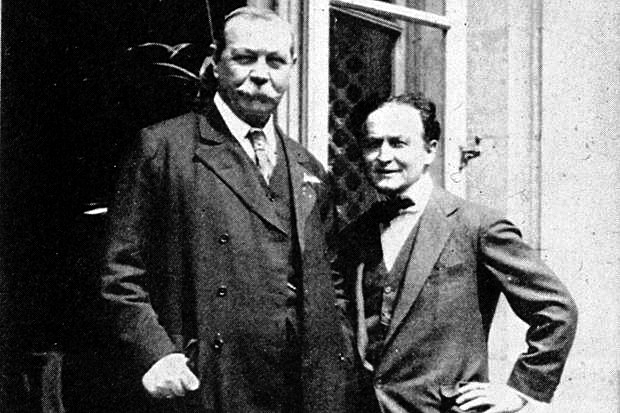Houdini & Doyle premieres May 2nd on Fox.
Zombos Says: Good
Much creative rearrangement of historic timelines and relationships for Sir Arthur Conan Doyle and Harry Houdini takes place in Fox's Houdini & Doyle. This may be annoying to those familiar with the history of spiritualism and how Doyle and Houdini fit into it, but the inclusion of fictional Adelaide Stratton (Rebecca Liddiard), the first female constable of Scotland Yard, and the dramatis personae needs of bringing their relationship to where mystery-of-the-week episodes can be written, rearrangements often happen.
In the premiere episode, The Maggie's Redress, a nun is murdered. A witness believes the murderer to be a ghost. Scotland Yard is incredulous. The mystery begins and the sensational newspaper headlines attract both Doyle (Stephen Mangan) and Houdini (Michael Weston) to investigate. Each has his own agenda for doing so. Doyle is a strong believer and supporter in supernatural phenomena and spiritualism, Houdini isn't. They meet at Scotland Yard but the police want nothing to do with them after Doyle's fictional detective makes coppers appear amateurish, and after Houdini's escapes from British jail cells makes those coppers look incompetent. As a devious compromise to appease Doyle and Houdini, Constable Stratton is assigned to chaperon them while making sure they, and especially her, do not do any real detective work. When she enters the room, Houdini asks her to get him a cup of coffee. Typical behavior in the age before women's lib.
The year is 1901. Doyle had killed off Holmes eight years earlier (in The Final Problem) but clamoring fans force him to publish The Hound of the Baskervilles in 1901, a story set before Holmes's death. Doyle rather focus on writing about things he deems more important than Holmes. No mention is made of Hound, though, as he reluctantly attends a book signing. An ardent fan dressed as Holmes tells Doyle the game is afoot. Doyle isn't amused. He wishes his The Great Boer War, published in 1900, was in demand instead of Holmes's stories. Doyle would become a true believer in spiritualism, and faeries, after the deaths of his son, wife, brother, and brothers-in-law, but this would not happen until later. It also won't be until the 1920s that Houdini energetically challenges, debunks, and exposes spiritualists; and his signature escape, the Chinese Water Torture Cell, well dramatized in this episode, will not make its debut until 1913.
Why both men believe or disbelieve is given in brief moments. For Doyle, it's finding proof of the afterlife, so he can give people hope; for Houdini, it's during a party he's throwing, attended by Tesla, Winston Churchill, and an actor playing the King who couldn't make it, all to impress his mother, whom he adored. Oddly, Houdini's wife Bess is MIA. He tells the constable how frustrated he is that his excellence at magic gives people false belief in the supernatural. In real life, Doyle would attribute supernatural powers to Houdini when the magician walked through solid brick walls and vanished elephants from the stage. Their tenuous friendship would not last.
Rearrangements aside, The Maggie's Redress is a tidy ghost story and mystery with enough lightheartedness mixed with tragedy. It highlights Doyle's deductive mind in action, a tad biased toward finding proof of the afterlife in contrast to Houdini's Coney Island showiness and self-assuredness in finding a rational answer. Constable Stratton just wants to get out of the Yard's basement, where she's working long hours and being ignored by the men who think a woman's place is in the home. Or hidden away in basements.
Every ghost story needs a tragedy at its heart, and here it's not the nun's murder, but what instigates it and where it takes place: a Magdalene Laundry, which were real-life asylums for "fallen women" run by nuns around the turn of the century. For twelve or more hours a day, young women would do their penance-work in these penitentiary workhouses. A wager made by Houdini and accepted by Doyle sends them off to find the murderer, living or deceased, within its depressing walls. If Houdini wins, Doyle will send him a first edition of The Great Boer War.
Daisies, a loose floorboard, and the ghost's appearance provide clues, but the greater story is the age unfolding around them. One filled with many wonders for the new century, which provides a colorful backdrop for these colorful men of mystery, magic, and adventure. And many challenges for Constable Stratton as she fights for recognition and equality.





Comments